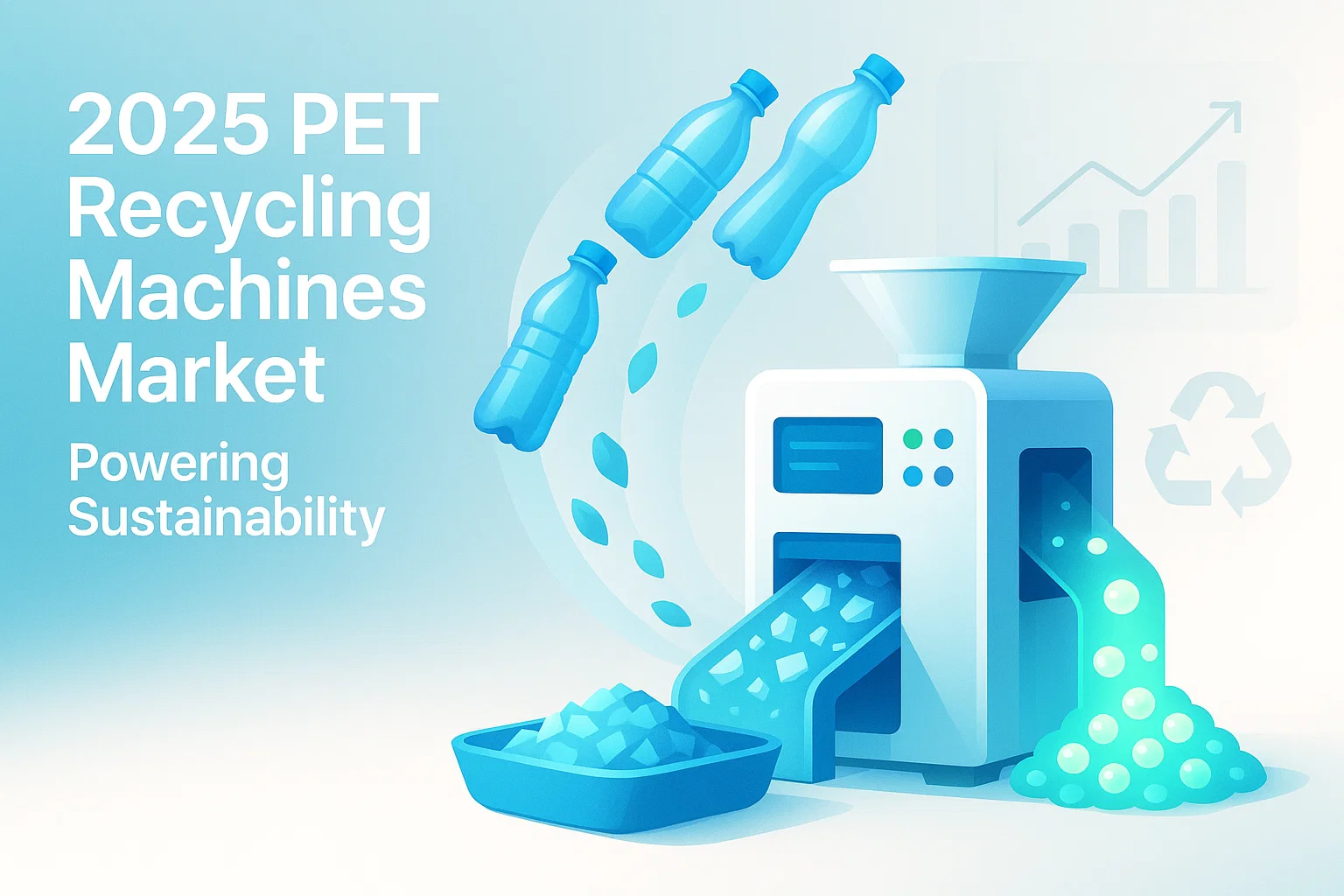Market Size and Growth Projections
The PET recycling machines market is experiencing robust expansion, driven by increasing environmental awareness and regulatory pressures. According to industry reports, the global PET bottle recycling market was valued at USD 5.8 billion in 2024 and is projected to reach USD 8.6 billion by 2033, growing at a compound annual growth rate (CAGR) of 4.42%. The broader plastic recycling equipment market, including PET-specific machines, is expected to grow from USD 3.59 billion in 2024 to USD 5.46 billion by 2031, with a CAGR of 6.2%.
Key Market Statistics
|
متري
|
2024 Value
|
Projected 2032 Value
|
CAGR
|
|---|---|---|---|
|
PET Bottle Recycling Market
|
USD 5.8B
|
USD 8.6B
|
4.42%
|
|
Plastic Recycling Machine Market
|
USD 3.59B
|
USD 5.46B
|
6.2%
|
|
Engineering Plastic Recycling Market
|
12.83M tons
|
19.38M tons
|
7.03%
|
Key Drivers of Market Growth
1. Stringent Environmental Regulations
Governments worldwide are implementing policies to reduce plastic waste and promote a circular economy. For example, the European Union’s Packaging and Packaging Waste Directive mandates that PET beverage bottles contain at least 25% recycled content by 2025, increasing to 30% by 2030. Similarly, the U.S. Save Our Seas 2.0 Act and state-level laws like California’s SB 54 encourage investment in recycling infrastructure. These regulations drive demand for high-efficiency PET recycling machines capable of producing food-grade rPET.
2. Rising Consumer and Corporate Sustainability Goals
Consumer demand for eco-friendly products is pushing brands to adopt sustainable practices. Major corporations, such as Unilever and Coca-Cola, have pledged to incorporate significant amounts of recycled PET into their packaging. This trend increases the need for advanced recycling equipment to meet quality and volume requirements.
3. Technological Advancements
Innovations in PET recycling technology, such as AI-driven sorting systems and chemical recycling processes, are enhancing efficiency and output quality. For instance, companies like Loop Industries and Carbios are pioneering depolymerization techniques that revert PET to its monomers, enabling high-quality recycling without material degradation. Additionally, energy-efficient machines with automated sorting and self-cleaning filters are reducing operational costs and improving scalability.
4. Growing Plastic Waste Volumes
Over 300 million tons of plastic are produced annually, with PET bottles constituting a significant portion. Only 9% of plastic waste is currently recycled, highlighting the urgent need for efficient recycling solutions. PET recycling machines, particularly crushing and washing lines, are critical for processing post-consumer bottles into reusable materials.
Emerging Trends in PET Recycling Machines
1. Automation and AI Integration
2. Chemical Recycling Advancements
3. Energy-Efficient Designs
4. Closed-Loop Recycling Systems
PET Recycling Machine Workflow
graph TD
A[Collection of PET Bottles] --> B[Sorting]
B --> C[Shredding/Crushing]
C --> D[Washing]
D --> E[Drying]
E --> F[Pelletizing]
F --> G[Quality Testing]
G --> H[Production of rPET Products]Process Breakdown
-
مجموعة: Post-consumer PET bottles are collected via deposit return systems or waste management programs.
-
فرز: Automated systems (e.g., near-infrared sorters) separate PET from other plastics and contaminants.
-
تمزيق / سحق: Machines like those from Baoding Haorui Machinery reduce PET bottles into flakes, with capacities ranging from 600 kg/h to 2,000 kg/h.
-
Washing: Advanced washing lines, such as those from Genius Machinery, remove labels, adhesives, and contaminants.
-
تجفيف: Energy-efficient drying systems ensure flakes are ready for further processing.
-
التكوير: Pelletizers produce uniform rPET pellets for use in new products.
-
Quality Testing: Ensures compliance with food-grade standards or other industry requirements.
Performance Comparison of Key PET Recycling Machines
|
Machine Type
|
السعة (كجم/ساعة)
|
Energy Consumption (kWh/kg)
|
الميزات الرئيسية
|
|---|---|---|---|
|
Crushing Machine
|
600–2,000
|
0.45
|
High throughput, versatile for PET/HDPE/PP
|
|
التقطيع
|
500–1,200
|
0.60
|
Precise cutting, durable blades
|
|
خط الغسيل
|
500–3,000
|
0.50
|
Self-cleaning filters, contaminant removal
|
|
بيليتايزر
|
300–2,000
|
0.55
|
Uniform pellet production, energy-efficient
|
Challenges in the PET Recycling Machines Market
- High Initial Costs: Advanced recycling equipment requires significant capital investment, which can be a barrier for small and medium-sized enterprises.
- Contamination Issues: Mixed plastic waste and multi-layered plastics are difficult to process, requiring advanced sorting technologies.
- Uneven Waste Collection: Inconsistent waste collection infrastructure in some regions limits the supply of recyclable PET.
- Competition from Virgin Plastics: Cheaper virgin plastics can undermine the demand for recycled materials, though regulatory incentives are helping bridge this gap.
Opportunities for Industrial Buyers
-
Invest in Automation: AI-driven machines offer higher efficiency and lower operational costs, providing a strong return on investment.
-
Explore Chemical Recycling: Investing in chemical recycling equipment can position companies as leaders in producing high-quality rPET.
-
Leverage Government Incentives: Grants and subsidies, such as those offered by North Carolina’s DEQ or the U.S. Department of Energy, can offset equipment costs.
-
Partner with Rumtoo: At Rumtoo Plastic Recycling Machinery, we offer customizable, energy-efficient PET recycling solutions tailored to your operational needs. Our machines, from crushers to washing lines, are designed to maximize throughput and quality.
Regional Insights
- North America: Leading the market with a 47.4% share in 2025, driven by strong recycling infrastructure and regulatory support. The U.S. accounts for 60% of global demand for plastic recycling machinery.
- Europe: The fastest-growing region with a CAGR of 7.51%, fueled by EU mandates and sustainability goals. Germany leads due to its emphasis on circular economy practices.
- Asia-Pacific: Rapid industrialization and urbanization in China and India drive demand, with China targeting 60% urban waste reuse by 2025.
- Emerging Markets: Latin America and the Middle East are investing in recycling infrastructure to meet global sustainability standards.



